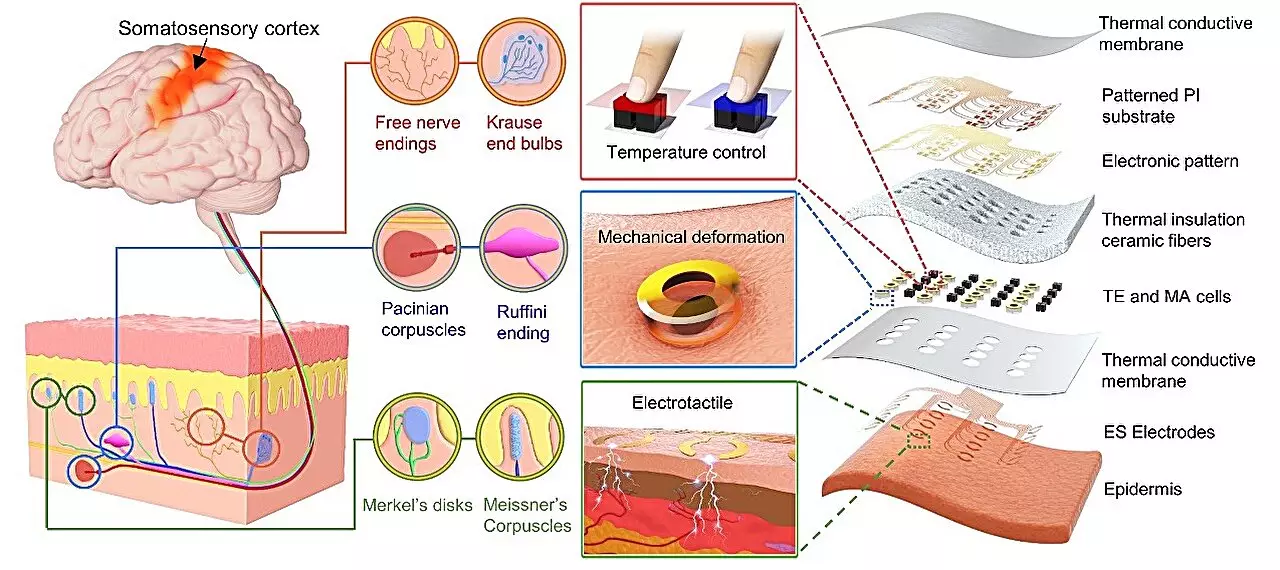Virtual reality (VR) and augmented reality (AR) technologies have come a long way in recent years, offering captivating gaming experiences and innovative forms of media entertainment. However, there is a need for improvement in terms of stimulating additional senses beyond vision and hearing. Researchers at the City University of Hong Kong, in collaboration with other institutions in China, have been working diligently to develop new interfaces that would enable users to experience virtual environments through their sense of touch. In a groundbreaking publication in Nature Electronics, they introduced a cutting-edge haptic interface that directly delivers multi-dimensional tactile signals to the skin, creating realistic sensations that have the potential to elevate virtual experiences to new heights.
The team, led by Professor Xinge Yu, has been focusing on the development of haptic interfaces based on flexible electronics. In their recent publication in Nature Machine Intelligence, they presented a wireless electrostimulation haptic interface. However, this paper primarily emphasized the overall creation of haptic feedback, rather than the generation of diverse immersive tactile sensations. Acknowledging this gap, the researchers designed a haptic feedback interface in their most recent work, selectively stimulating different receptors to reproduce corresponding tactile sensations, thus striving for a more authentic experience.
To achieve the goal of enhancing haptic feedback, the team introduced a novel activation principle. Their haptic system stimulates various sensory receptors and sensation nerves in the human body, which, when combined with VR or AR technology, has the potential to create even more realistic and immersive experiences. Traditionally, haptic feedback technology has primarily focused on electrical stimulation or mechanical actuation. Electrical stimulation aims to activate nerves accurately to generate real tactile sensations, while mechanical actuation replicates the deformation of the skin’s surface when interacting with objects. Integrating the advantages of both approaches, the team managed to achieve diverse and immersive tactile feedback effects, breaking down the barriers that previously hindered progress in this domain.
The researchers’ breakthrough lies in their ability to selectively stimulate different touch receptors, based on the distribution of these receptors and the activation of sensory nerves in the human body. By combining electrical stimulation and mechanical actuation, their innovative approach opens up new possibilities for providing users with richer and more realistic touch experiences. This experiment not only pushes the boundaries of haptic feedback but also presents an exciting opportunity to create highly immersive VR content accompanied by lifelike tactile sensations.
The skin-integrated multimodal haptic interface developed by this team marks a significant milestone in haptic technology research. Moving forward, this work could pave the way for the creation of truly immersive VR experiences, with realistic tactile feedback. However, there is still much to be explored and developed in the field of haptic feedback. Various areas of research, such as material synthesis, mechanical structure optimization, and neuro electrophysiology, are closely intertwined with the design principles and fabrication of haptic interfaces. It is through further advancements in these areas that the potential of haptic feedback can be fully realized.
With the increasing sophistication of VR and AR technologies, the development of enhanced haptic interfaces is crucial to bridging the gap between virtual and real-world experiences. The groundbreaking work carried out by researchers at the City University of Hong Kong represents a significant step forward in achieving this goal. By integrating multiple feedback modes and providing diverse tactile sensations, their haptic interface has the potential to revolutionize the way we immerse ourselves in virtual environments. As the field of haptic feedback continues to evolve, researchers and developers must collaborate and explore new innovations to unlock the full potential of this exciting technology.


Leave a Reply